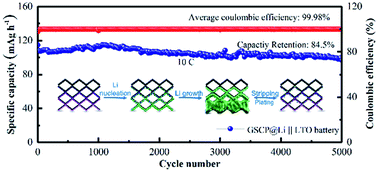Bottom-top channeling Li nucleation and growth by a gradient lithiophilic 3D conductive host for highly stable Li-metal anodes†
Abstract
Li metal anodes are undergoing a renaissance due to their ultra-high specific capacity and the lowest reduction potential. However, the practical application of Li-metal anodes is still challenged by Li dendrite growth and low coulombic efficiency (CE). Herein, a gradient Si-modified carbon paper (GSCP) made via magnetic sputtering is proposed to address these issues, in which the content of lithiophilic Si gradually decreases from the bottom to the top of the 3D host. Such a gradient lithiophilic structure can cause the Li metal to selectively nucleate and grow at the bottom first and then to the top part of GSCP, realizing stable Li plating/stripping and high space utilization of the 3D host simultaneously. Therefore, the designed GSCP composite anode achieves average CEs of 99.0% (400 cycles) and 97.0% (150 cycles) at 1 and 5 mA cm−2, respectively, and a prolonged lifespan (1350 h) with a low overpotential (∼15 mV). Remarkably, the GSCP@Li‖Li4Ti5O12 full cell exhibits high capacity retention of 84.5% after 5000 cycles at a 10C rate.



 Please wait while we load your content...
Please wait while we load your content...